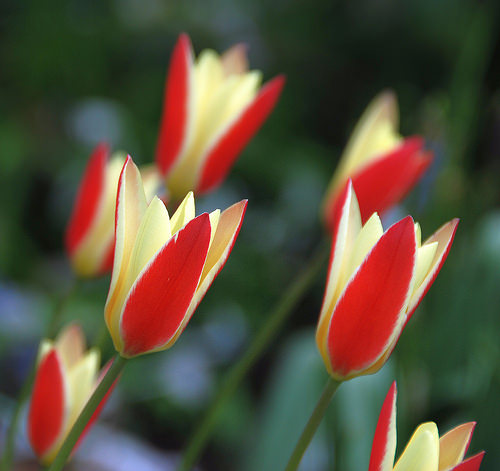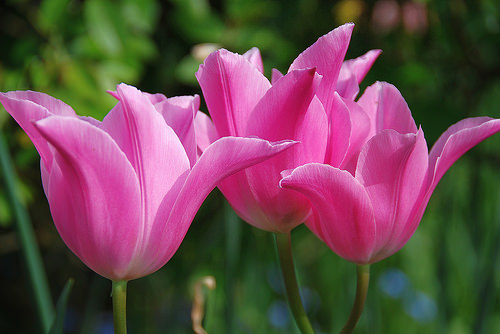Check out these import direct from china images:
Leaning Towards the Light….

Image by antonychammond
These tulips were searching for the sun in our garden last spring.
The tulip is a perennial, bulbous plant with showy flowers in the genus Tulipa, of which around 75 wild species are at the moment accepted and which belongs to the family Liliaceae.
The genus’s native variety extends west to the Iberian Peninsula, by means of North Africa to Greece, the Balkans, Turkey, throughout the Levant (Syria, Israel, Palestine, Lebanon, Jordan) and Iran, North to Ukraine, southern Siberia and Mongolia, and east to the Northwest of China. The tulip’s centre of diversity is in the Pamir, Hindu Kush, and Tien Shan mountains. It is a typical element of steppe and winter-rain Mediterranean vegetation. A quantity of species and many hybrid cultivars are grown in gardens, as potted plants, or as cut flowers.
Tulips are spring-blooming perennials that develop from bulbs. Based on the species, tulip plants can be amongst four inches (ten cm) and 28 inches (71 cm) higher. The tulip’s huge flowers generally bloom on scapes with leaves in a rosette at ground level and a single flowering stalk arising from amongst the leaves.Tulip stems have handful of leaves. Bigger species tend to have numerous leaves. Plants usually have two to six leaves, some species up to 12. The tulip’s leaf is strap-shaped, with a waxy coating, and the leaves are alternately arranged on the stem these fleshy blades are often bluish green in color. Most tulips create only 1 flower per stem, but a few species bear numerous flowers on their scapes (e.g. Tulipa turkestanica). The generally cup or star-shaped tulip flower has 3 petals and 3 sepals, which are usually termed tepals because they are nearly identical. These six tepals are typically marked on the interior surface close to the bases with darker colorings. Tulip flowers come in a wide selection of colors, except pure blue (many tulips with "blue" in the name have a faint violet hue).
The flowers have six distinct, basifixed stamens with filaments shorter than the tepals. Every single stigma has 3 distinct lobes, and the ovaries are superior, with three chambers. The tulip’s seed is a capsule with a leathery covering and an ellipsoid to globe shape. Each capsule includes numerous flat, disc-shaped seeds in two rows per chamber. These light to dark brown seeds have very thin seed coats and endosperm that does not generally fill the entire seed.
Etymology
The word tulip, first pointed out in western Europe in or around 1554 and seemingly derived from the "Turkish Letters" of diplomat Ogier Ghiselin de Busbecq, first appeared in English as tulipa or tulipant, entering the language by way of French: tulipe and its obsolete form tulipan or by way of Contemporary Latin tulīpa, from Ottoman Turkish tülbend ("muslin" or "gauze"), and might be in the end derived from the Persian: دلبند delband ("Turban"), this name becoming applied due to the fact of a perceived resemblance of the shape of a tulip flower to that of a turban. This might have been due to a translation error in early occasions, when it was trendy in the Ottoman Empire to put on tulips on turbans. The translator possibly confused the flower for the turban.
Tulips are known as laleh (from Persian لاله, lâleh) in Persian, Turkish, Arabic, and Bulgarian. In Arabic letters, "laleh" is written with the very same letters as Allah, which is why the flower became a holy symbol. It was also associated with the Home of Osman, resulting in tulips becoming extensively used in decorative motifs on tiles, mosques, fabrics, crockery, and so on. in the Ottoman Empire
Cultivation
Tulip cultivars have usually numerous species in their direct background, but most have been derived from Tulipa suaveolens, usually erroneously listed as Tulipa schrenkii. Tulipa gesneriana is in itself an early hybrid of complicated origin and is possibly not the identical taxon as was described by Conrad Gesner in the 16th century.
Tulips are indigenous to mountainous places with temperate climates and need a period of cool dormancy, known as vernalization. They thrive in climates with lengthy, cool springs and dry summers. Tulip bulbs imported to warm-winter areas of are often planted in autumn to be treated as annuals.
Tulip bulbs are normally planted around late summer and fall, in well-drained soils, normally from 4 to 8 inches (ten to 20 cm) deep, depending on the kind. Species tulips are normally planted deeper.
Propagation
Tulips can be propagated via bulb offsets, seeds or micropropagation. Offsets and tissue culture methods are implies of asexual propagation for producing genetic clones of the parent plant, which maintains cultivar genetic integrity. Seeds are most typically employed to propagate species and subspecies or to generate new hybrids. Numerous tulip species can cross-pollinate with each and every other, and when wild tulip populations overlap geographically with other tulip species or subspecies, they often hybridize and develop mixed populations. Most industrial tulip cultivars are complicated hybrids, and often sterile.
Offsets need a year or more of development before plants are big sufficient to flower. Tulips grown from seeds often require 5 to eight years ahead of plants are of flowering size. Commercial growers normally harvest the tulip bulbs in late summer and grade them into sizes bulbs huge enough to flower are sorted and sold, although smaller bulbs are sorted into sizes and replanted for sale in the future. The Netherlands are the world’s principal producer of commercial tulip plants, generating as numerous as 3 billion bulbs annually, the majority for export.
For further information please go to en.wikipedia.org/wiki/Tulip
Beauty Can Be Noticed in the Pink of an Eye!

Image by antonychammond
These tulips were opening up to the sun in our garden final spring.
The tulip is a perennial, bulbous plant with showy flowers in the genus Tulipa, of which around 75 wild species are presently accepted and which belongs to the family Liliaceae.
The genus’s native range extends west to the Iberian Peninsula, by means of North Africa to Greece, the Balkans, Turkey, all through the Levant (Syria, Israel, Palestine, Lebanon, Jordan) and Iran, North to Ukraine, southern Siberia and Mongolia, and east to the Northwest of China. The tulip’s centre of diversity is in the Pamir, Hindu Kush, and Tien Shan mountains. It is a common element of steppe and winter-rain Mediterranean vegetation. A number of species and many hybrid cultivars are grown in gardens, as potted plants, or as cut flowers.
Tulips are spring-blooming perennials that develop from bulbs. Based on the species, tulip plants can be among four inches (10 cm) and 28 inches (71 cm) higher. The tulip’s huge flowers typically bloom on scapes with leaves in a rosette at ground level and a single flowering stalk arising from amongst the leaves.Tulip stems have couple of leaves. Bigger species tend to have several leaves. Plants usually have two to six leaves, some species up to 12. The tulip’s leaf is strap-shaped, with a waxy coating, and the leaves are alternately arranged on the stem these fleshy blades are often bluish green in colour. Most tulips make only a single flower per stem, but a few species bear several flowers on their scapes (e.g. Tulipa turkestanica). The usually cup or star-shaped tulip flower has 3 petals and 3 sepals, which are usually termed tepals since they are almost identical. These six tepals are typically marked on the interior surface near the bases with darker colorings. Tulip flowers come in a wide variety of colors, except pure blue (a number of tulips with "blue" in the name have a faint violet hue).
The flowers have six distinct, basifixed stamens with filaments shorter than the tepals. Each stigma has 3 distinct lobes, and the ovaries are superior, with three chambers. The tulip’s seed is a capsule with a leathery covering and an ellipsoid to globe shape. Every capsule consists of several flat, disc-shaped seeds in two rows per chamber. These light to dark brown seeds have extremely thin seed coats and endosperm that does not generally fill the complete seed.
Etymology
The word tulip, 1st talked about in western Europe in or around 1554 and seemingly derived from the "Turkish Letters" of diplomat Ogier Ghiselin de Busbecq, initial appeared in English as tulipa or tulipant, entering the language by way of French: tulipe and its obsolete type tulipan or by way of Modern day Latin tulīpa, from Ottoman Turkish tülbend ("muslin" or "gauze"), and may be eventually derived from the Persian: دلبند delband ("Turban"), this name becoming applied simply because of a perceived resemblance of the shape of a tulip flower to that of a turban. This might have been due to a translation error in early occasions, when it was fashionable in the Ottoman Empire to wear tulips on turbans. The translator possibly confused the flower for the turban.
Tulips are known as laleh (from Persian لاله, lâleh) in Persian, Turkish, Arabic, and Bulgarian. In Arabic letters, "laleh" is written with the exact same letters as Allah, which is why the flower became a holy symbol. It was also linked with the House of Osman, resulting in tulips being widely employed in decorative motifs on tiles, mosques, fabrics, crockery, etc. in the Ottoman Empire
Cultivation
Tulip cultivars have typically several species in their direct background, but most have been derived from Tulipa suaveolens, usually erroneously listed as Tulipa schrenkii. Tulipa gesneriana is in itself an early hybrid of complicated origin and is almost certainly not the same taxon as was described by Conrad Gesner in the 16th century.
Tulips are indigenous to mountainous locations with temperate climates and require a period of cool dormancy, known as vernalization. They thrive in climates with lengthy, cool springs and dry summers. Tulip bulbs imported to warm-winter places of are often planted in autumn to be treated as annuals.
Tulip bulbs are normally planted about late summer time and fall, in well-drained soils, generally from 4 to 8 inches (ten to 20 cm) deep, depending on the type. Species tulips are typically planted deeper.
Propagation
Tulips can be propagated via bulb offsets, seeds or micropropagation. Offsets and tissue culture methods are implies of asexual propagation for making genetic clones of the parent plant, which maintains cultivar genetic integrity. Seeds are most often employed to propagate species and subspecies or to produce new hybrids. A lot of tulip species can cross-pollinate with each other, and when wild tulip populations overlap geographically with other tulip species or subspecies, they frequently hybridize and develop mixed populations. Most commercial tulip cultivars are complex hybrids, and frequently sterile.
Offsets call for a year or far more of development prior to plants are big sufficient to flower. Tulips grown from seeds frequently need to have 5 to eight years ahead of plants are of flowering size. Commercial growers usually harvest the tulip bulbs in late summer time and grade them into sizes bulbs massive enough to flower are sorted and sold, although smaller bulbs are sorted into sizes and replanted for sale in the future. The Netherlands are the world’s main producer of commercial tulip plants, making as several as three billion bulbs annually, the majority for export.
For further data please go to en.wikipedia.org/wiki/Tulip